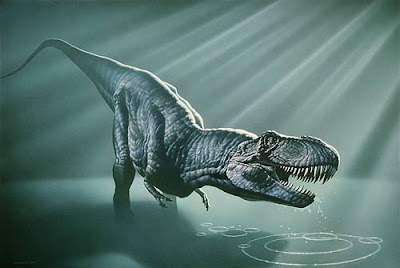
The “beast-footed” carnivorous dinosaurs
What Is a theropod?
The theropod (meaning "beast-footed") dinosaurs are a diverse group of bipedal saurischian dinosaurs. They include the largest terrestrial carnivores ever to have made the earth tremble. What most people think of as theropods (e.g., T. rex, Deinonychus) are extinct today, but recent studies have conclusively shown that birds are actually the descendants of small nonflying theropods. Thus when people say that dinosaurs are extinct, they are technically not correct. Still it's not as exciting seeing a sparrow at your birdfeeder as it would be to see a Tyrannosaurus rex there
CHARACTERS
Several characters that typify a theropod: hollow, thin. walled bones are diagnostic of theropod dinosaurs A jumbled box containing theropod bones. The hollow nature of the bones is certainly more obvious in 3D, but you should at least be able to make out the general tubular structure of the bones. Other theropod characters include modifications of the hands and feet. Most theropods had sharp, recurved teeth useful for eating flesh, and claws were present on the ends of all of the fingers and toes
HISTORY
Our knowledge of the evolutionary history of the Theropoda is constantly under revision stimulated by new, exciting fossil finds every year or so such as Mononykus olecranus, a very bird-like theropod found recently in the Mongolian desert, or Giganotosaurus carolinii, a giant theropod probably rivaling the size of T.rex., found recently in Argentina. In fact, the 1960's discovery and study of the remains of Deinonychus antirrhopus helped to revise paleontology's old vision of all dinosaurs as slow, stupid reptiles, and was a key factor in the onset of the controversial hot-blooded/cold-blooded debate.
FACTORS
Theropod remains are fairly rare and more often than not, fragmentary — theropods have a poor fossil record compared to most of the ornithischian dinosaurs. Fossils of small theropods are especially rare, since small bones are harder to find and are weathered away easily. Without well-preserved, complete specimens, it is hard to tell who is most closely related to whom using cladistics.

THEROPOD CLASSIFICATION
- The Herrerasauridae are an early group represented by Herrerasaurus, which was discovered in a wonderful middle-late Triassic period fossil locality in Argentina in the 1970s.
- Another herrerasaur is Staurikosaurus, which has been known since the 1960s from remains found in Brazil. More recently (in 1993).
- Another herrerasaur-like fossil was found in the same general area and named Eoraptor, or "dawn thief." It appears to be closely related to the herrerasaurs, but smaller in size and slightly older

No comments:
Post a Comment